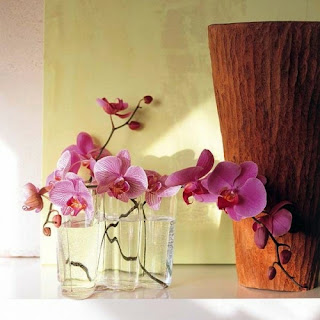Orchid, the exotic plant!
The beauty, complexity and incredible diversity of orchid flowers are unrivalled in the world of plants. Orchids are renowned for their exotic looking flowers in the most exquisite shapes and colors. You can enjoy these absolute beauties in your own home and garden, for months. With the correct care, orchids will flower for a second time! These exotic plants comprise the largest family of flowering plants on earth, with over 30,000 different species, and at least 200,000 hybrids. With so many different orchid varieties that thrive in so many different growing conditions, it is easy to find an orchid that is well suited to any place.
Orchids are usually grouped into two broad categories that characterize their growth habits. Monopodial orchids have a single, upright stem, with leaves arranged opposite each other along the stem. The flower stem appears from the base of the uppermost leaves. Orchids with this growth habit include the phalaenopsis and vandas.
The more common growth habit is sympodial. These orchids grow horizontally, sending out new shoots from the old rhizome. Leaves and flower scapes form at the top of the new shoots. Sympodial orchids include cattleya, cymbidium, oncidium and dendrobium.
Nowadays we can find blooming orchids every season of the year, but most varieties flowering in winter and spring. Bright exception phalaenopsis orchid flowers last up to three months.
The flower pot you choose for your orchid should be relatively small. Plastic pots are preferred because when it’s time to repot, the roots can be more easily detached, or the pots can simply be cut apart. What is very important is having drainage holes. The container should be changed when your plant grows disproportionately to the size of the pot, which we notice is happening every 2-3 years.
On the other hand clay pot is also good, because the clay allows the soil to dry faster and the roots better breathing.
Orchids do not prefer soil but stones, gravel, wood or peat. These materials are commercially available and can be easily purchased to fill your pot.
Some orchids should be repotted every year. Others may be happy in the same pot for more years. As a general rule, don’t repot your orchid unless:
Potting mix breaks down, often evidenced by dead roots, or the plant outgrowing the container.
After the bloom is done, go ahead and cut off the dead flower spike and repot the plant. Orchids should be potted into specialized orchid pots in an orchid mixture. Remove it from the pot and carefully remove as much of the moss as you can. Healthy roots should be white and firm, with a small green growing point. Cut away any shriveled, rotten or blackened roots. Set the plant into the pot and fill in around it with potting mixture.
Once it's repotted, find a good spot. An east-facing window with a few hours of mild morning sun is perfect. To provide the necessary humidity and catch run-off water, put the plant into a wide, deep tray and fill the tray with gravel.
Lighting and temperature
Plenty of sunlight strengthens the flowering of the orchid. Orchids need shiny, filtered light and must be orientated to the east or south. But know that the orchid for better flowering needs to spend a few hours in the dark. So do not place your pots in places with natural or artificial light 24 hours a day.
The right temperature strengthens its flowering. The orchid does not love extreme temperatures, whether it's too hot or hot. The right temperature of the surrounding area of the orchid is important both for its survival as long as it is and for its flowering. The temperature suggested is between 15-27 C° per day and 11-15 C° at night.
Watering
Most orchids can tolerate drought far better than they can tolerate excess moisture. Nothing kills an orchid faster than letting it sit in a water-logged pot. As a very general rule, orchids should be watered once a week. The most common way to watering your orchid is to sink your pot in a bowl or bucket with lukewarm, never cold water. Leave it there for a few minutes to absorb as much water as it needs and soak it all up its soil. Allow it to dry and remove the extra water. Important is to allow the soil to dry completely before the next watering.
Fertilizer
Your plant will show you how often fertilizer is needed. Usually once a month it is enough. Use a liquid fertilizer. Fertilizer should only be applied when plants are in active growth. This means that most orchids should not be fertilized in midwinter or right after they have been repotted.
Propagation
Propagating orchids from seed is quite difficult. Unlike the seeds of other plants, orchid seeds do not contain nutritional storage tissues. To grow, the seed must land where it will find a particular kind of fungi that can penetrate its root system and convert nutrients into a usable form. An orchid seed typically disburses millions of microscopic seeds, which can be carried hundreds of miles from the mother plant. Some kind of orchids, grow in soil. But most tropical orchids are epiphytes, which mean that they grow in the air, rather than in soil. Their fleshy roots are covered with a layer of white cells called velamen, which acts as a sponge to absorb water. The coating also protects the roots from heat and moisture loss. It is far easier to propagate orchids by division. But remember that dividing a plant means forsaking blooms for at least a year. Also, the larger the orchid plant, the more flowers it will produce. Small divisions take many years to mature.
The stunning orchid will provide joy and beauty throughout its blooming season, but it also makes a centerpiece everyone will envy. You can find several orchid varieties online at anthemionflowers.com which you will love to give or keep for yourself!
